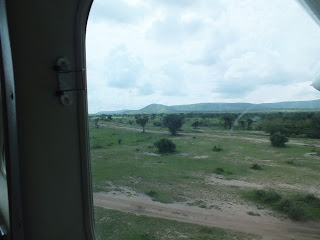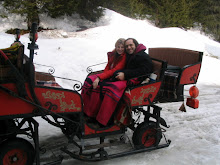From where I sit, I can
see a herd of Impalas and a few waterbuck grazing on the banks of the Mara
River, the main river here in the Maasai Mara. I am sitting outside my tent at
Entim camp, and now I REALLY feel like I'm in Africa!

I feel like I’m a
character in one of those old adventure books. Native porters clad in
traditional colored robes carried our bags while the ‘head boy’ in his crisp
camp uniform led the way to our sprawling tent with its huge bed, massive
redwood trunk, and a tile-floored bathroom with shower and toilet.
The whole camp runs on
solar energy so power only exists between 5am-6:30am and 6:30pm – 10:30.
All during lunch we
could hear hippos down by the river grunting. As I walked back to my tent, at a
bend in the river, I could just make out some shapes on the water. Focusing my
field glasses, I could see the heads of 3 hippos. Returning about 5 minutes
later, one of them had hoisted himself half out of the water onto a rock or
something, his enormous butt rising into the air.
 The grazing herds were
in view throughout lunch, with a pair of large warthogs joining the mix. A
baboon wandered by about 30 yards from my table.
The grazing herds were
in view throughout lunch, with a pair of large warthogs joining the mix. A
baboon wandered by about 30 yards from my table. We got here on a tiny
plane holding about 12 passengers. It made 3 stops, like a bus, landing in tiny
airfields that were little more than dirt roads.
We got here on a tiny
plane holding about 12 passengers. It made 3 stops, like a bus, landing in tiny
airfields that were little more than dirt roads. Hey, a loud shot just went off! There are armed guards around the camp to offer protection from the prowling predators.
Anyway, from the air we could see countless kraals, the circular farmsteads or villages of the local population surrounded by thorn-bush barricades just as you read about in those 19thcentury African safari accounts. On our second take off, I spotted a lone elephant trekking along a vast empty expanse of veldt. I turned my head and spotted six more frolicking in the water. Mind you, this was from 2000 feet, but I could still tell they were elephants.
There’s a weird noise
coming from behind my tent somewhere, and one of the guards is staring intently
in that direction. The camp has armed guards and you’re not allowed to leave
the enclosure without one. Enclosure? There is NO enclosure; the camp is open
to the wild – what I meant was the area with gravel footpaths and moderately
low grass.

We were met at the
airport by our guide, Dominic, and another driver who transported us to a very
swanky lodge with a pool and a spa, etc. But we merely passed through here to
arrive at a rope bridge swaying over a low gorge. And it really was swaying;
enough that is was difficult to cross carrying a duffle bag and a backpack. The
sign at the far side read: Do not pass this point without armed escort.
We saw a troop of
baboons within 5 minutes of leaving the airport.
 Before long we
encountered our first elephant! Huge, with sweeping tusks and a large chunk
torn form one of his ears, he was truly magnificent! Dominic told us males live
alone between 45-60 when they are tired of long marches with the herd.
Before long we
encountered our first elephant! Huge, with sweeping tusks and a large chunk
torn form one of his ears, he was truly magnificent! Dominic told us males live
alone between 45-60 when they are tired of long marches with the herd.
We got settled in camp
and had lunch in the dining tent. It was a vegetable tortilla. Yuck. So I had
them cook me bacon and eggs! They were extremely accommodating. There are only
two other guests besides us, so they are doting on us and eager to please.
We had our first game
drive at 3:30 with the other guests, two Japanese ladies, a mother and daughter
I think. Within two minutes, we had encountered a troop of giraffe, perhaps 15
in number with a similar sized host further off down a defile. These are Maasai
giraffes, with a more star-shaped pattern on their skins, plus it extends all
the way down to their hooves, unlike the Rothschilds with their ‘white socks.’
This area is a HUGE
expanse of land (580 square miles) and game is plentiful. One becomes almost
accustomed to the vast herds of various antelopes. We saw a Zebra which Dominic
said was sort of rare at this time of year, since the migration had already
passed through. At Somali, we had seen several herds.
Within 10 minutes of
setting out, we found a pride of 7 lions lazing about, 3 on sentinel duty,
meaning they were at least sitting up, and four young adults totally sacked
out, rolled over on their backs, etc.
We marveled at their
cuteness for a while, and then drove on while our guides scouted for the larger
lions, reasoning that the rest of the pride would be nearby.

Having known the pride
since they were born, our guides had some prescience of where they might be.
They drove up to a thick bush, and there, barely visible inside, was a sleeping
male.
He would not stir,
despite the fact that they drove the jeep right up to the edge of the bush.
Apparently, He was accustomed to their habits as well. We pulled a little way
off to scan the fields with our field glasses when suddenly he stirred himself
and strode majestically from his hiding spot.

The lions are totally
unconcerned with our vehicle and allowed us to be within mere feet of them. In
fact, this one nearly brushed the bumper as he strolled past. Some of the herd
animals are quite skittish, but I guess if these lions grew up around these
safari vehicles they know they have nothing to fear from them. Dominic says
it’s a totally different story should one get out of the vehicle.
The lion coughed a few times, then out of the high grass, a black-maned head pops up. His brother, Dominic tells us. We watched them yawn and stretch for a while and were about to depart when some excitement strolled in.
 A beautiful female
walked boldly up to the males; when the black-maned one rose to meet her, the
other one got in a huff and the two met in a thunderous, roaring clash.
A beautiful female
walked boldly up to the males; when the black-maned one rose to meet her, the
other one got in a huff and the two met in a thunderous, roaring clash.
The battle lasted but a
few seconds before the victor strutted off with the female. It was the lighter
colored male, and even victorious he now carried a bloody wound under his eye.
He and the female repaired down the road a bit, where she sat in the middle of the track preening herself while he sat on his haunches, licking and yawning, exposing massive jaws.
Shortly after this, our
vehicle got a flat tire, and we stood out on the swampy expanse about 100 yards
or so from the lions while our two guides worked to change the tire. It was
rough going because of the mud, and I had to lend a hand at one point. The
slimmer of the two could not turn the jack anymore, and he cast a curious
glance at my arms when I stepped in and began rapidly twisting it.
The girls kept a watch
on the three visible lions while we got the tire changed.

When we arrived back at
camp, a fire was crackling overlooking the river and a spectacular sunset. The
shades had been let down in our tent and we were served gin and tonics while we
recline on canvas camp chairs.
 After drinks by the
fire, we went up to the dining tent and had a luxurious dinner of chicken soup
followed by tilapia fillets and potatoes with a fruit salad for desert.
After drinks by the
fire, we went up to the dining tent and had a luxurious dinner of chicken soup
followed by tilapia fillets and potatoes with a fruit salad for desert.
When we got back to the
tent, our covers had been turned down and a chocolate was waiting on the
pillow. Two hot water bottles warmed the sheets.
Luxury camping, indeed!




























